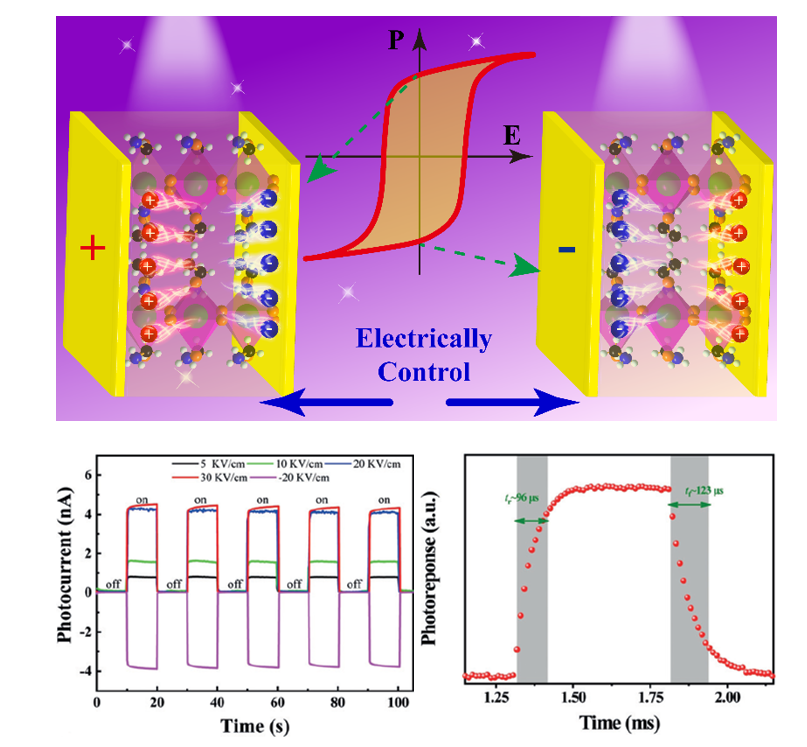
Self-powered photodetection referring to sensing light signals without an external power source, displays promising application foreground in next-generation portable and energy-efficient photoelectric devices. Ferroelectric materials, especially hybrid perovskite ferroelectrics, have a promising position for generating a high-voltage controllable power supply by ferroelectric polarization to trigger light detection.
Recently, in a study published in Angew. Chem. Int. Ed., a research group led by Prof. LUO Junhua from Fujian Institute of Research on the Structure of Matter (FJIRSM) of the Chinese Academy of Sciences demonstrated the realization of self-powered photodetection in a two-dimensional (2D) perovskite ferroelectric, (CH3CH2NH3)2(CH3NH3)2Pb3Br10.
The researchers constructed hybrid perovskite (CH3CH2NH3)2(CH3NH3)2Pb3Br10 by tailored alloying of small flexible organic ethylamine into 3D prototype of CH3NH3PbBr3, which adopts a typical Ruddlesden-Popper (RP) perovskite framework with a formula of (A')2(A)n-1MnX3n+1. Distinct from that of 3D MAPbBr3, this unique 2D structure possesses multiple quantum wells and dielectric confinement effects, endowing (CH3CH2NH3)2(CH3NH3)2Pb3Br10 with remarkable semiconducting property.
Particularly, the distinct symmetry breaking with 4/mmmFmm2 species leads to the emergence of four equivalent ferroelectric polarization directions in (CH3CH2NH3)2(CH3NH3)2Pb3Br10, which displays high Curie temperature (375K), superior spontaneous polarization (3.7 μC/cm2). The combination of ferroelectric and semiconducting feature provides great opportunities to achieve efficient self-powered photodetection.
By exploiting ferroelectric polarization induced by internal inversion symmetry breaking as a desirable driving force for carrier separation, the researchers achieved efficient and tunable self-powered photoresponse in a single-phase polarized crystal of (CH3CH2NH3)2(CH3NH3)2Pb3Br10.
Without external power supply, (CH3CH2NH3)2(CH3NH3)2Pb3Br10 shows large photocurrent density (~4.1 μAcm-2), high on/off switching ratio (over 106) and ultrafast response time (96/123 μs). These figures-of-merit are comparable and even better than previously reported devices whether they are self-powered or not.
Further investigations revealed a highly relevant of spontaneous polarization (ferroelectricity) and self-powered photodetection behavior in (CH3CH2NH3)2(CH3NH3)2Pb3Br10, that is to say the polarization induced by internal inversion symmetry breaking provides a desirable carriers separation driving force, involving such electrically tunable self-powered sensitive activity in (CH3CH2NH3)2(CH3NH3)2Pb3Br10.
This study opens a new pathway to design new multifunctional ferroelectric materials and promote the design of hybrid perovskite ferroelectrics for intelligent optoelectronic devices.

Schematic of the tunable photocurrent directions with inversion of polarization direction under external electrically poling and efficient self-powered photodetection with (CH3CH2NH3)2(CH3NH3)2Pb3Br10 (Image by Prof. LUO’s group)

86-10-68597521 (day)
86-10-68597289 (night)

86-10-68511095 (day)
86-10-68512458 (night)

cas_en@cas.cn

52 Sanlihe Rd., Xicheng District,
Beijing, China (100864)

